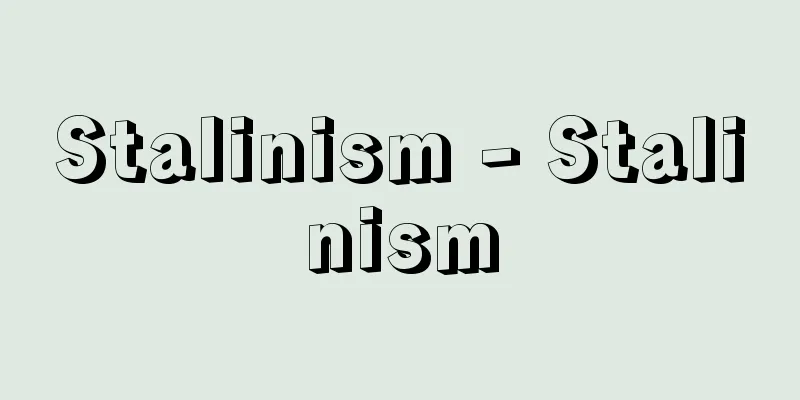Stalinism - Stalinism

|
A term that characterizes the ideas and work of the Soviet politician Stalin. During his lifetime, it was once used positively as an idea and theory that developed Marxism and Leninism, but after his death, it has been used exclusively in a negative sense to refer to his personality cult, mass purges, bureaucratic leadership, and Soviet-centered great power ideology. The following points are often pointed out as its characteristics. (1) Socialism in one country Stalin wrote The Foundations of Leninism in 1924, and at the end of the same year proposed the theory of "socialism in one country." He argued that even if revolutions did not occur in the developed countries of Western Europe, the Soviet Union alone "can and must build a complete socialist society." In response, the "left wing," including Trotsky, Zinoviev, and Kamenev, criticized Stalin's "national narrow-mindedness" and advocated internationalism and development into a world revolution based on Marx's "theory of permanent revolution," but was rejected. At the time, Stalin, along with Bukharin, advocated cooperation with peasants and a slow pace of industrialization, but after the expulsion of the "left wing," he dismissed Bukharin and others as "right wing" and adopted a course of rapid industrialization and agricultural collectivization, and this forced and comprehensive collectivization was called a "revolution from above." After that, he promoted industrialization based on five-year plans and succeeded in making the Soviet Union an industrial nation. (2) One-party system and dictatorship of the proletariat Based on his experience with the Russian Revolution, Stalin considered a one-party system to be the "basic condition" for the dictatorship of the proletariat, and denied the possibility of a multi-party system. According to him, the dictatorship of the proletariat is "essentially" the dictatorship of the Communist Party, and the relationship between the three parties - party → mass organizations → masses - must be hierarchical, in which the party, as the "highest form of class organization," makes decisions, mass organizations (soviet organizations, labor unions, cooperatives, etc.) play the role of the party's "transmission belt," and the masses become the execution force of the party's will. Therefore, the party and the state are integrated, and labor unions are merely one part of the "transmission belt" subordinate to the party = state. (3) Monolithism Stalin not only absolutized the one-party system, but also considered the Communist Party to be a "monolithic organization." He elevated the ban on factions decided at the 10th Party Congress to an eternal principle, and insisted that minority views be overcome not through ideological struggle but through systematic elimination. Furthermore, using the logic that class struggle would intensify as socialist construction progressed, he carried out mass repression and purges of all critical forces, including party and military officials, and established a personal dictatorship. (4) Great Power Nationalism Stalin narrowly defined an ethnic group as "a historically constructed and solid community of a psychological state manifested in commonality of language, region, economic life, and culture," and considered an ethnic group to be a modern thing that was established during the rise of capitalism. This definition of an ethnic group applies only to a few civilized large ethnic groups, and Jews and minority ethnic groups in the outlying regions are not considered "ethnic groups." Therefore, as long as we follow this definition, it may be that only large ethnic groups are recognized as having the "right to national self-determination." In fact, Stalin considered the Russians to be the leading ethnic group among the ethnic groups that made up the Soviet Union, and forced the surrounding ethnic minorities to relocate and oppressed the Jews. After World War II, when the "People's Democratic Revolution" was successful in Eastern European countries under the occupation of the Soviet army, Stalin subordinated these countries to the Soviet Union and excommunicated Yugoslavia, which adopted an independent position, from the international communist movement. On the one hand, Stalin stirred up patriotism through nationalistic slogans such as "socialism in one country" and "the Great Patriotic War," and succeeded in industrializing and defending the Soviet Union. However, under his leadership, Comintern was subordinated to Soviet diplomacy, and "proletarian internationalism" came to mean Soviet-centrism. Stalin also concluded agreements with Nazi Germany and the United States and Britain to divide spheres of influence, choosing the path of deciding the fate of other nations through negotiations between the great powers. He effectively did not recognize the right of nations to self-determination, and adopted the position of great-power nationalism. (5) Theory of striking the main blow against Social Democracy, theory of social fascism Stalin called the Social Democrats "objectively the moderate wing of Fascism," from which the label "social fascism" was born. Furthermore, he advocated the "theory of striking the main blow against Social Democracy," which gave top priority to the fight against Social Democracy, and called for concentrating attacks on its left wing in particular. This sectarian line spread internationally through Comintern, and was one of the factors that allowed the victory of German fascism. Stalinism not only held great power within the Soviet Union, but also spread internationally through Comintern and Cominform. Thälmann of the German Communist Party and Treize of the French Communist Party are said to have been typical Stalinists. [Noboru Shida] [References] | |Source: Shogakukan Encyclopedia Nipponica About Encyclopedia Nipponica Information | Legend |
|
ソ連の政治家スターリンの思想と事業を特徴づけることば。スターリン存命中は、マルクス主義、レーニン主義を発展させた思想・理論として一時は肯定的に用いられたが、その死後は、個人崇拝、大量粛清や官僚主義的指導、ソ連中心の大国主義などをさすものとして、もっぱら否定的な意味で用いられている。その特徴としてしばしば指摘されるのは、次の諸点である。 (1)一国社会主義 スターリンは1924年に『レーニン主義の基礎』を著し、同年末「一国社会主義」論を提唱した。彼は、西欧の先進国で革命が起こらなくても、ソ連一国だけで「完全な社会主義社会を建設し遂げることができるし、また建設し遂げなければならない」と主張した。これに対して、トロツキー、ジノビエフ、カーメネフら「左派」は、スターリンの「民族的偏狭さ」を批判し、マルクス以来の「永続革命論」に基づき国際主義、世界革命への発展を唱えたが退けられた。スターリンは当時ブハーリンとともに農民との協力、緩慢なテンポの工業化を主張していたが、「左派」の追放後、ブハーリンらを「右派」として退け、一転して急速な工業化と農業集団化の路線を採用、その強制的・全面的な集団化は「上からの革命」とよばれた。以後、五か年計画に基づく工業化を推進し、ソ連を工業国にすることに成功した。 (2)一党制とプロレタリア独裁 スターリンはロシア革命の経験から一党制をプロレタリアート独裁の「基本的条件」とみなし、複数政党制の可能性を否定した。彼によれば、プロレタリアート独裁は「本質的には」共産党独裁であり、党→大衆組織→大衆の三者の関係は、「階級組織の最高形態」としての党が意思を決定し、大衆組織(ソビエト機関、労働組合、協同組合など)が党の「伝導ベルト」の役割を果たし、大衆が党の意思の実行部隊となる、という階層制でなければならない。したがって、党と国家は一体化され、労働組合も党=国家に従属した「伝導ベルト」の一つにすぎない。 (3)一枚岩主義 スターリンは一党制を絶対化しただけでなく、共産党を「一枚岩の組織」とみなした。彼は、第10回党大会決定の分派禁止を永遠の原則に高め、少数派の見解を思想闘争によってではなく、組織的排除によって克服するよう主張した。さらに、社会主義建設が前進するにつれて階級闘争が激化するという論理を用いて、党幹部・軍幹部を含むいっさいの批判勢力に大量弾圧・粛清を加え、個人独裁を確立した。 (4)大国民族主義 スターリンは、民族を「言語、地域、経済生活および文化の共通性のうちに現れる心理状態の歴史的に構成された堅固な共同体」と狭く定義し、民族を資本主義の勃興(ぼっこう)期に成立する近代的なものとみなした。この民族の定義が当てはまるのは若干の文明化した大民族に限られ、ユダヤ人や辺境の少数種族は「民族」ではないことになってしまう。したがって、この定義に従う限り「民族自決権」をもつことが認められるのも大民族に限られることになりかねない。事実、スターリンは、ソビエト連邦を構成する諸民族のうちロシア人を指導的民族とみなし、周辺の少数民族を強制移住させたり、ユダヤ人に圧迫を加えたりした。第二次世界大戦後、東欧諸国でソ連軍の占領下で「人民民主主義革命」が成功すると、スターリンはこれらの諸国をソ連に従属させ、自主的な立場をとったユーゴスラビアを国際共産主義運動から破門した。 一面では、スターリンは「一国社会主義」「大祖国戦争」などの民族主義的スローガンによって愛国心を駆り立て、ソ連の工業化と防衛を成功させた。しかし、彼の指導のもとでコミンテルンはソ連外交に従属させられ、「プロレタリア国際主義」はソ連中心主義を意味するものとなった。また、スターリンはナチス・ドイツや英米と勢力圏分割協定を結び、他民族の運命を大国間の交渉で決定する道を選んだ。彼は、民族の自決権を事実上認めず、大国民族主義の立場をとったのである。 (5)社民主要打撃論、社会ファシズム論 スターリンは社会民主党を「客観的にはファシズムの穏和な一翼」とよび、ここから社会民主主義に対する「社会ファシズム」というレッテルが生じた。さらに彼は、社会民主主義との闘争を最優先させる「社会民主主義主要打撃論」を唱え、とくにその左派に打撃を集中するよう主張した。このセクト的な路線はコミンテルンを通じて国際的に広がり、ドイツ・ファシズムの勝利を許す一要因となった。 スターリン主義は、ソ連内部で大きな権力を握ったばかりでなく、コミンテルンやコミンフォルムを通じて国際的にも波及した。ドイツ共産党のテールマンやフランス共産党のトレーズなどは典型的なスターリン主義者であったといわれる。 [志田 昇] [参照項目] | |出典 小学館 日本大百科全書(ニッポニカ)日本大百科全書(ニッポニカ)について 情報 | 凡例 |
>>: Stalin's Constitution - Stalin's Constitution
Recommend
Xin-shou (English spelling)
A divorce letter used in China since ancient times...
New Covenant - New Contract
… The New Testament originally expressed this cov...
sarcomere
…The striations consist of a dark A band and a li...
Lokāyata (English spelling)
...Ajita's theory of the four elements comple...
Tsuguharu Foujita
Born: November 27, 1886 in Tokyo, Japan [Died] Jan...
Joint Jury System - Sanshinsei
A form of public participation in the judiciary. ...
Alitoria dik-dik - Alitoria dik-dik
...The young weigh 600g at birth and reach maturi...
Revolutionäre Obleute (English spelling) revolutionare Obleute
… The year 1917, when the revolution broke out in...
Ikutahara [town] - Ikutahara
A former town in Monbetsu County, northeastern Hok...
Ainoko - Ainoko
...They come in a variety of sizes, but are usual...
Shinobu Orikuchi
A scholar of Japanese literature, folklorist and ...
"Encouragement of Learning" - Kankakuhen
…In 1896, 13 Chinese students arrived in Japan fo...
Basiccio
…His real name was Giovanni Battista Gaulli. He w...
Azusa Yumi
[1] [noun] ① A bow made from the Azusa tree. In an...
Great-grey kangaroo
An animal of the Marsupial order of the Mammalia ...









